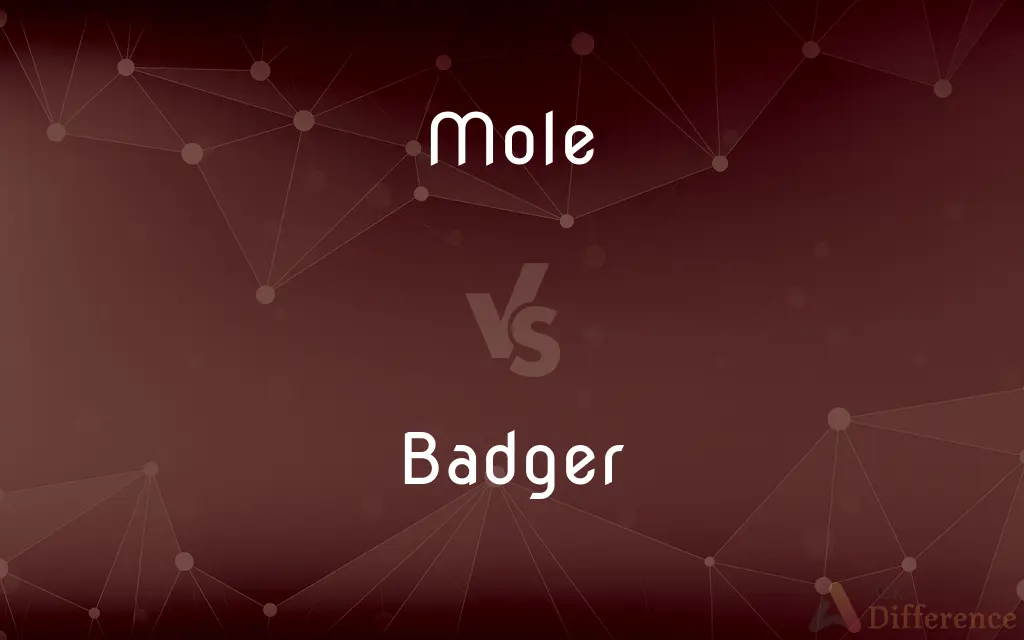Mole vs. Badger — What's the Difference?
By Tayyaba Rehman — Updated on November 3, 2023
A mole is a small, burrowing mammal with velvety fur, known for its underground tunnels, while a badger is a larger, more robust burrowing mammal, recognizable by its white-striped face.

Difference Between Mole and Badger
Table of Contents
ADVERTISEMENT
Key Differences
Moles are small mammals adapted to a subterranean lifestyle, with cylindrical bodies and velvety fur. Badgers, in comparison, are larger, belonging to the same family as otters, polecats, weasels, and wolverines, and are characterized by their stocky bodies and significant digging abilities.
While moles are solitary creatures that spend most of their lives underground, feeding primarily on earthworms and other small invertebrates found in the soil, badgers are known for their social structures and often live in larger family groups known as cetes. Badgers have a more varied diet, eating a range of foods from earthworms to fruit and even small mammals.
The mole's eyes and ears are small to prevent clogging while burrowing, which contrasts with the badger's more prominent eyes and ears, suited for an above-ground lifestyle as well as foraging at night. Additionally, moles have powerful, broad forelimbs with large paws adapted for digging, unlike badgers whose forelimbs are strong but not solely for digging.
The lifespan of a mole is typically shorter than that of a badger, with moles living around 3 to 5 years in the wild, while badgers can live up to 14 years. This is partly due to the badger's larger size and more varied diet, which contribute to its longer life.
Lastly, the fur of a mole is soft and dense, allowing it to move in all directions without resistance from the soil. Badgers, however, have coarser fur, with a distinctive black and white face patterning that moles lack, since moles do not need such markings for camouflage or communication.
ADVERTISEMENT
Comparison Chart
Size
Small
Larger
Habitat
Underground
Both underground and above ground
Social Structure
Solitary
Social, lives in groups
Diet
Mainly earthworms
Omnivorous, varied diet
Lifespan
Shorter (3-5 years)
Longer (up to 14 years)
Compare with Definitions
Mole
A burrowing insectivorous mammal
The mole dug a network of tunnels in the garden.
Badger
A native of Wisconsin
As a Badger, she supported the University of Wisconsin football team.
Mole
A unit of measurement in chemistry
One mole of carbon atoms equals 12 grams.
Badger
A brush with thick bristles
He lathered his beard using a badger hair brush.
Mole
A defect or mark on the skin
She had a small mole on her cheek.
Badger
A burrowing carnivorous mammal
The badger emerged from its sett at dusk.
Mole
A spy within an organization
The agency discovered a mole leaking information.
Badger
To pester or nag persistently
He badgered them for an update every hour.
Mole
A massive structure in a harbor
The mole protected the harbor from the rough sea.
Badger
Badgers are short-legged omnivores mostly in the family Mustelidae (which also includes the otters, polecats, weasels, and ferrets), but also with two species called "badgers" in the related family Mephitidae (which also includes the skunks). Badgers are a polyphyletic grouping, and are not a natural taxonomic grouping: badgers are united by their squat bodies, adapted for fossorial activity.
Mole
A small burrowing mammal with dark velvety fur, a long muzzle, and very small eyes, feeding mainly on worms, grubs, and other invertebrates.
Badger
Any of several carnivorous burrowing mammals of the family Mustelidae, such as Meles meles of Eurasia or Taxidea taxus of North America, having short legs, long claws on the front feet, and a heavy grizzled coat.
Mole
A spy who gradually achieves an important position within the security defences of a country
A well-placed mole was feeding them the names of operatives
Badger
The fur or hair of any of these mammals.
Mole
A small, often slightly raised blemish on the skin made dark by a high concentration of melanin
A mole on her arm had not been there at the beginning of the summer
Badger
Any of several similar mammals, such as the ratel.
Mole
A large solid structure on a shore serving as a pier, breakwater, or causeway.
Badger
To ask or nag (someone) about something in an annoying and persistent way; pester
Badgered the boy into cleaning his room.
Mole
The SI unit of amount of substance, equal to the quantity containing as many elementary units as there are atoms in 0.012 kg of carbon-12.
Badger
Any mammal of three subfamilies, which belong to the family Mustelidae: Melinae (Eurasian badgers), Mellivorinae (ratel or honey badger), and Taxideinae (American badger).
Mole
An abnormal mass of tissue in the uterus.
Badger
A native or resident of the American state, Wisconsin.
Mole
A highly spiced Mexican sauce made chiefly from chilli peppers and chocolate, served with meat.
Badger
(obsolete) A brush made of badger hair.
Mole
A skin lesion, commonly a nevus, that is typically raised and discolored.
Badger
A crew of desperate villains who robbed near rivers, into which they threw the bodies of those they murdered.
Mole
Any of various small insectivorous mammals of the family Talpidae of North America and Eurasia, usually living underground and having a thickset body with light brown to dark gray silky fur, strong forefeet for burrowing, and often rudimentary eyes.
Badger
(obsolete) An itinerant licensed dealer in commodities used for food; a hawker; a huckster; -- formerly applied especially to one who bought grain in one place and sold it in another.
Mole
A machine that bores through hard surfaces, used especially for tunneling through rock.
Badger
To pester; to annoy persistently; to press.
He kept badgering her about her bad habits.
Mole
A spy who operates from within an organization, especially a double agent operating against that agent's own government from within its intelligence establishment.
Badger
An itinerant licensed dealer in commodities used for food; a hawker; a huckster; - formerly applied especially to one who bought grain in one place and sold it in another.
Mole
A massive, usually stone wall constructed in the sea, used as a breakwater and built to enclose or protect an anchorage or a harbor.
Badger
A carnivorous quadruped of the genus Meles or of an allied genus. It is a burrowing animal, with short, thick legs, and long claws on the fore feet. One species (Meles meles or Meles vulgaris), called also brock, inhabits the north of Europe and Asia; another species (Taxidea taxus or Taxidea Americana or Taxidea Labradorica) inhabits the northern parts of North America. See Teledu.
Mole
The anchorage or harbor enclosed by a mole.
Badger
A brush made of badgers' hair, used by artists.
Mole
A fleshy abnormal mass formed in the uterus by the degeneration or abortive development of an ovum.
Badger
To tease or annoy, as a badger when baited; to worry or irritate persistently.
Mole
In the International System, the base unit used in representing an amount of a substance, equal to the amount of that substance that contains as many atoms, molecules, ions, or other elementary units as the number of atoms in 0.012 kilogram of carbon-12. The number is 6.0221 × 1023, or Avogadro's number. See Table at measurement.
Badger
To beat down; to cheapen; to barter; to bargain.
Mole
A pigmented spot on the skin, a naevus, slightly raised, and sometimes hairy.
Badger
Sturdy carnivorous burrowing mammal with strong claws widely distributed in the northern hemisphere
Mole
Any of several small, burrowing insectivores of the family Talpidae; also any of southern African mammals in the family Chrysochloridae (golden moles) and any of several Australian mammals in the family Notoryctidae (marsupial moles), similar to but not closely related to Talpidae moles
Badger
Annoy persistently;
The children teased the boy because of his stammer
Mole
Any of the burrowing rodents also called mole-rats.
Badger
Persuade through constant efforts
Mole
(espionage) An internal spy, a person who involves himself or herself with an enemy organisation, especially an intelligence or governmental organisation, to determine and betray its secrets from within.
Badger
A grade of quality for brushes
The artist preferred badger brushes for oil painting.
Mole
A kind of self-propelled excavator used to form underground drains, or to clear underground pipelines
Mole
A type of underground drain used in farm fields, in which a mole plow creates an unlined channel through clay subsoil.
Mole
A moll, a bitch, a slut.
Mole
(nautical) A massive structure, usually of stone, used as a pier, breakwater or junction between places separated by water.
Mole
(rare) A haven or harbour, protected with such a breakwater.
Mole
(historical) An Ancient Roman mausoleum.
Mole
In the International System of Units, the base unit of amount of substance; the amount of substance of a system which contains exactly 6.02214076×1023 elementary entities (atoms, ions, molecules, etc.). Symbol: mol. The number of atoms is known as Avogadro’s number. from 1897
Mole
A hemorrhagic mass of tissue in the uterus caused by a dead ovum.
Mole
One of several spicy sauces typical of the cuisine of Mexico and neighboring Central America, especially a sauce which contains chocolate and which is used in cooking main dishes, not desserts.
Mole
A spot; a stain; a mark which discolors or disfigures.
Mole
A spot, mark, or small permanent protuberance on the human body; esp., a spot which is dark-colored, from which commonly issue one or more hairs.
Mole
A mass of fleshy or other more or less solid matter generated in the uterus.
Mole
A mound or massive work formed of masonry or large stones, etc., laid in the sea, often extended either in a right line or an arc of a circle before a port which it serves to defend from the violence of the waves, thus protecting ships in a harbor; also, sometimes, the harbor itself.
Mole
Any insectivore of the family Talpidæ. They have minute eyes and ears, soft fur, and very large and strong fore feet.
Mole
A plow of peculiar construction, for forming underground drains.
Mole
A spy who lives for years an apparently normal life (to establish a cover) before beginning his spying activities.
Mole
A quantity of a substance equal to the molecular weight of a substance expressed in grams; a gram molecule; the basic unit of amount of substance adopted under the System International d'Unites; as, he added two moles of sodium chloride to the medium.
Mole
To form holes in, as a mole; to burrow; to excavate; as, to mole the earth.
Mole
To clear of molehills.
Mole
The molecular weight of a substance expressed in grams; the basic unit of amount of substance adopted under the Systeme International d'Unites
Mole
A spy who works against enemy espionage
Mole
Spicy sauce often containing chocolate
Mole
A small congenital pigmented spot on the skin
Mole
A protective structure of stone or concrete; extends from shore into the water to prevent a beach from washing away
Mole
Small velvety-furred burrowing mammal having small eyes and fossorial forefeet
Common Curiosities
Can moles cause damage to gardens?
Yes, mole tunneling can disturb lawns and gardens.
How do moles sense their prey?
Moles use their sense of touch and smell to locate prey.
Are moles solitary?
Yes, moles are generally solitary outside of the breeding season.
Are moles blind?
Moles are not truly blind but have very poor eyesight.
What family do badgers belong to?
Badgers are part of the Mustelidae family.
Are badgers aggressive animals?
Badgers can be aggressive if threatened but generally avoid humans.
What time of day are badgers most active?
Badgers are nocturnal and most active at night.
What do badgers eat?
Badgers are omnivores; they eat earthworms, insects, small mammals, and plants.
Do badgers hibernate?
Badgers do not hibernate but can be less active during winter.
What is a group of badgers called?
A group of badgers is known as a cete.
Can you keep a mole as a pet?
Moles are wild animals and are not suitable as pets.
How do badgers contribute to the ecosystem?
Badgers control rodent populations and their burrows provide habitats for other species.
What is the primary diet of a mole?
Moles primarily eat earthworms and other soil invertebrates.
What do mole hills indicate?
Mole hills are the earth pushed up from deep mole tunnels and indicate mole activity.
Do moles have a particular breeding season?
Moles typically breed in late winter or early spring.
Share Your Discovery

Previous Comparison
Nauseous vs. Nauseated
Next Comparison
Slough vs. SlewAuthor Spotlight
Written by
Tayyaba RehmanTayyaba Rehman is a distinguished writer, currently serving as a primary contributor to askdifference.com. As a researcher in semantics and etymology, Tayyaba's passion for the complexity of languages and their distinctions has found a perfect home on the platform. Tayyaba delves into the intricacies of language, distinguishing between commonly confused words and phrases, thereby providing clarity for readers worldwide.















































